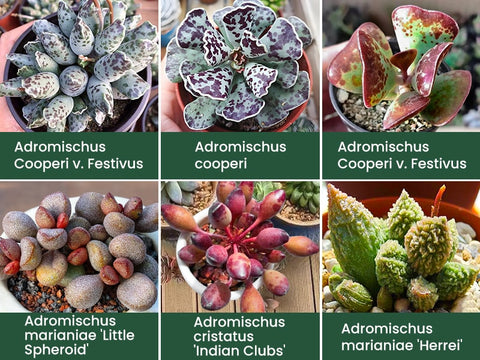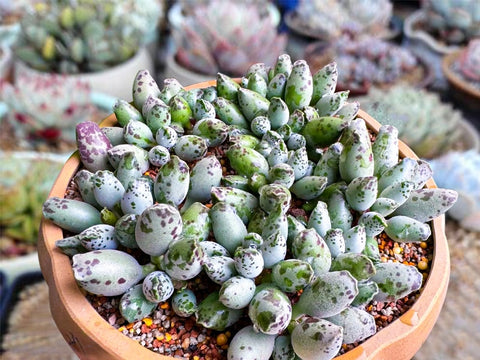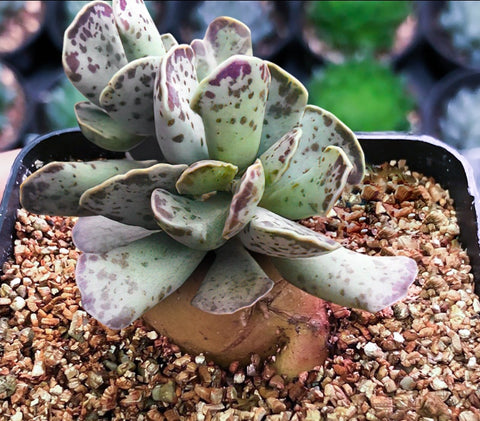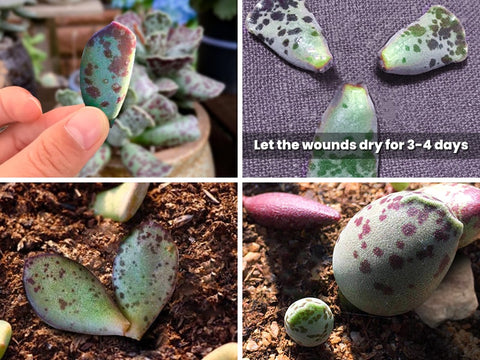Adromischus succulents, belonging to the Crassulaceae family, hail from South Africa and lurk in rock crevices and shrubs, often overlooked by many. Unlike the colorful Echeveria or the quirky Crassula, Adromischus has its unique charm and cool appearance, each boasting distinct shapes, spots, and textures.
Cool Adromischus Succulent Varieties
1. Adromischus Cooperi v. Festivus
3. Adromischus triflorus 'Calico Hearts'
4. Adromischus marianiae 'Little Spheroid'
5. Adromischus cristatus 'Indian Clubs'
6. Adromischus marianiae 'Herrei'

If you're captivated by the appearance of Adromischus, don't hesitate – this succulent is arguably one of the easiest to care for in the Crassulaceae family! Let's dive into how to care for Adromischus:
Caring for Adromischus Succulents
Light:
Most green Adromischus varieties prefer indirect light, and since they're small, they make great indoor plants, perfect for sprucing up your indoor plant space. Some spotted Adromischus varieties enjoy brighter light, resulting in more and deeper spots on their leaves, like Adromischus Cooperi v. Festivus, requiring at least 6 hours of direct sunlight. If kept outdoors, provide shade during summer.

Temperature:
As mentioned, Adromischus requires shade in summer to prevent sunburn and because it can't tolerate high temperatures. When temperatures exceed 85℉ (30°C), it goes into a dormant state, ceasing growth. Compared to Echeveria and Crassula, it prefers cooler temperatures, so good ventilation is essential during summer. Ideal temperatures range from 50-77℉ (10-25°C), promoting rapid growth in spring and autumn.
Watering:
Adromischus is a succulent with a tuberous root system, meaning it can store large amounts of water, so you don't need to water them frequently. This makes them perfect for those who often forget to water their plants – indeed, the best care for succulents is often neglect; just remember to water when you occasionally remember it. For beginners, observe the leaves of Adromischus – when they become soft and wrinkled, it's a clear sign they need water. Overwatering is fatal for Adromischus and often leads to root rot issues. You may wonder: How to care for overwatered succulents?
Tip: Water sparingly or stop watering during Adromischus' summer dormancy.
Soil and Potting:
For soil, follow the golden ratio for succulents: 40% potting soil mixed with 60% perlite. Since Adromischus has a tuberous root system susceptible to scratches from hard particles, opt for softer perlite, such as pumice.
Adromischus has a clumping growth habit, so when selecting pots, choose pots 1.5 times larger than the plant to allow ample growth space and ensure drainage holes at the bottom.

Fertilizing:
Adromischus thrives in nutrient-rich soil. I like to add some succulent-specific liquid fertilizer every spring. If you can, repot Adromischus annually with fresh soil to ensure ample nutrients, prevent soil compaction, and check for root rot and other diseases. You may wonder: How to fertilize succulents scientifically.
How to Propagate Adromischus Succulents
The connection between Adromischus' leaves and stems is less robust than Echeveria's and can be fragile, so handle it carefully to avoid knocking off leaves. However, if you accidentally knock off a leaf or two, it's an opportunity – you can use these leaf cuttings to propagate new Adromischus. Here's how:
1. Harvest fresh, healthy Adromischus leaves.
2. Let the wounds dry for 3-4 days until the growth points turn white.
3. Prepare fresh soil.
4. Gently insert the growth point of the succulent leaf into the soil.
5. Keep the leaf upright, with the back away from the soil surface.
6. Wait patiently for roots to grow – this may take 1-2 weeks.
7. Water lightly at the roots weekly, and your Adromischus babies will gradually grow.

Diseases and Pests
Adromischus succulents rarely suffer from pests, but they may contract powdery mildew, characterized by white spots resembling limescale on Adromischus leaves, usually due to poor ventilation after watering. The simplest treatment is to wipe the affected areas with alcohol-soaked cotton swabs. Repeat this process 2-3 times a week, and after 2 weeks, your plants should gradually improve.
Keep Adromischus Away from Pets and Children
Adromischus is considered toxic, and pets and children may be curious about them. Accidental ingestion can lead to poisoning, so don't put your loved ones in danger. You may wonder: 20 Toxic Succulents You Need to be Aware of.
Final Words
The succulent family is diverse, with some preferring the cute Echeveria, others the cool Adromischus, and some favoring the spiky cacti. Each succulent variety exudes its unique charm. What's your favorite succulent family? Comment and let us know.

























